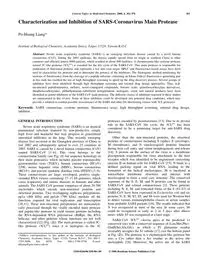
2006 Characterization and Inhibition of SARS-Coronavirus Main Protease PDF
Preview 2006 Characterization and Inhibition of SARS-Coronavirus Main Protease
Current Topics in Medicinal Chemistry, 2006, 6, 361-376 361 1568-0266/06 $50.00+.00 © 2006 Bentham Science Publishers Ltd. Characterization and Inhibition of SARS-Coronavirus Main Protease Po-Huang Liang* Institute of Biological Chemistry, Academia Sinica, Taipei 11529, Taiwan R.O.C Abstract: Severe acute respiratory syndrome (SARS) is an emerging infectious disease caused by a novel human coronavirus (CoV). During the 2003 epidemic, the disease rapidly spread from its origin in southern China to other countries and affected almost 8000 patients, which resulted in about 800 fatalities. A chymotrypsin-like cysteine protease named 3C-like protease (3CLpro) is essential for the life cycle of the SARS-CoV. This main protease is responsible for maturation of functional proteins and represents a key anti-viral target. HPLC and fluorescence-based assays have been used to characterize the protease and to determine the potency of the inhibitors. The fluorogenic method monitoring the increase of fluorescence from the cleavage of a peptide substrate containing an Edans-Dabcyl fluorescence quenching pair at two ends has enabled the use of high throughput screening to speed up the drug discovery process. Several groups of inhibitors have been identified through high throughput screening and rational drug design approaches. Thus, α,β- unsaturated peptidomimetics, anilides, metal-conjugated compounds, boronic acids, quinolinecarboxylate derivatives, thiophenecarboxylates, phthalhydrazide-substituted ketoglutamine analogues, isatin and natural products have been identified as potent inhibitors of the SARS-CoV main protease. The different classes of inhibitors reported in these studies are summarized in this review. Some of these inhibitors could be developed into potential drug candidates, which may provide a solution to combat possible reoccurrence of the SARS and other life-threatening viruses with 3CL proteases. Keywords: SARS coronavirus, cysteine protease, fluorescence assay, high throughput screening, rational drug design, inhibitor. GENERAL INTRODUCTION Severe acute respiratory syndrome (SARS) is an atypical pneumonial infection featured by non-productive cough, high fever and headache that may progress to generalized interstitial infiltrates in the lung. This recently emerging disease first occurred in the Guangdon province of China in late 2002 and subsequently spread to over 25 countries in 2003. SARS is caused by a novel human coronavirus (CoV) named SARS-CoV [1–6]. This virus belongs to the coronaviridae family (see Fig. (1) for sequence homology of their main proteases), which includes porcine transmissible gastroenteritis virus (TGEV), human coronavirus (HCoV) 229E, mouse hepatitis virus (MHV), bovine coronavirus (BCoV), and porcine epidemic diarrhea virus (PEDV) (7–9). These coronaviruses are large, enveloped, positive single- stranded RNA viruses containing 27–31 kb genomes, which cause respiratory and enteric diseases in humans and other animals. The SARS-CoV genome comprises of about 29,700 nucleotides which encode non-structural proteins and structural proteins. Two overlapping replicase polyproteins, pp1a (486 kDa) and pp1ab (790 kDa), mediate all the functions required for viral replication and transcription [10,11]. These non-structural polyproteins are autocatalyti- cally processed through the virally encoded main protease and papain-like protease to yield mature proteins including the RNA-dependent RNA polymerase (RdRp), the RNA helicase, and other proteins whose functions are not well characterized [12] (Fig. (2)). The main protease is called 3C- like protease (3CLpro) since it is analogous to the 3C *Address correspondence to this author at the Institute of Biological Chemistry, Academia Sinica, Taipei 11529, Taiwan R.O.C.; Tel: 886-2- 2785-5696; Ext: 6070; Fax: 886-2-2788-9759; E-mail:
